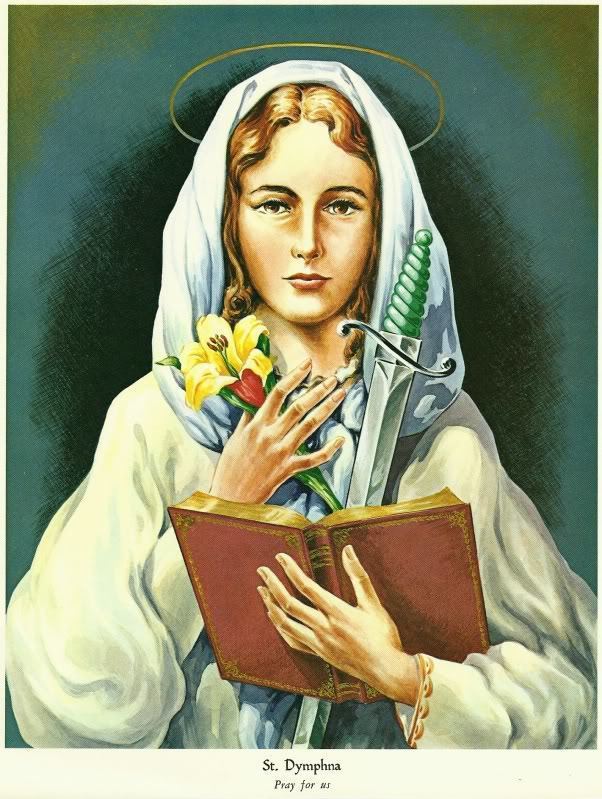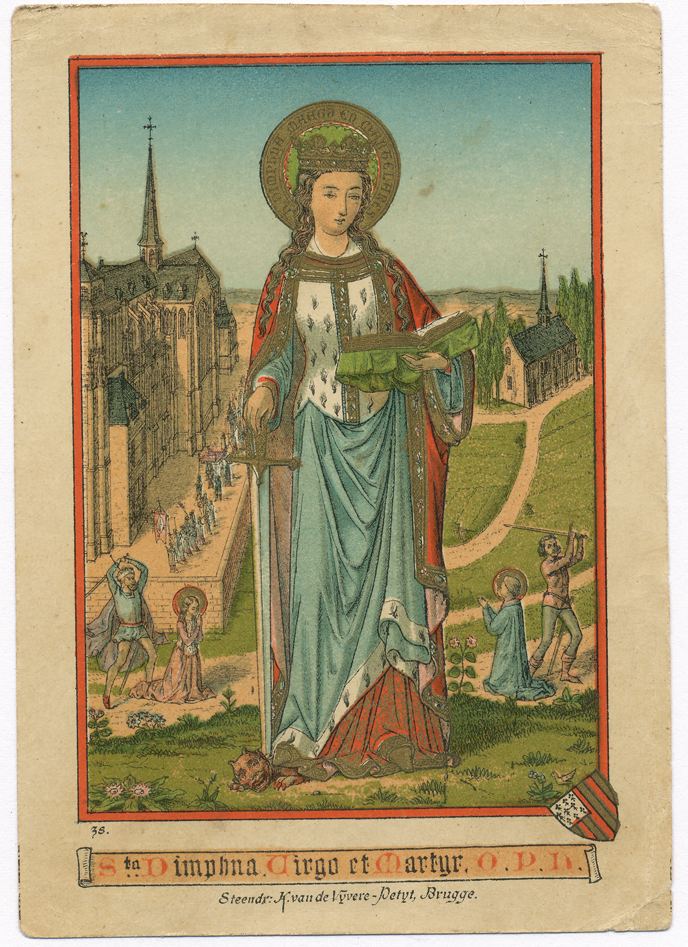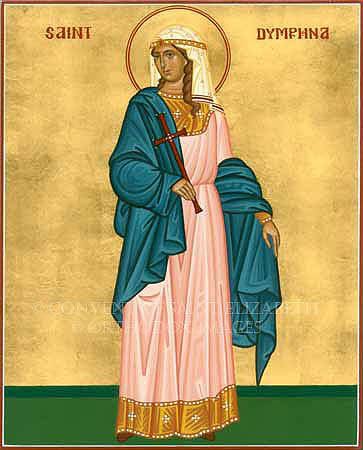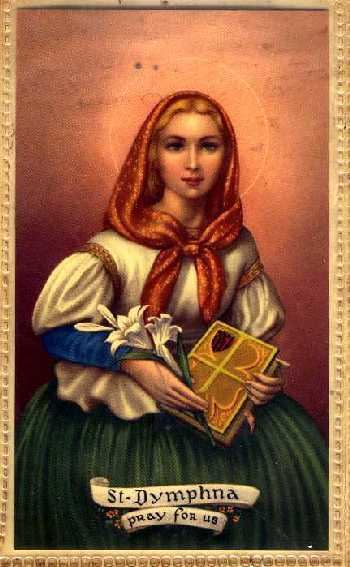Name Saint Dymphna Feast 15 May | ||
 | ||
Attributes crown, sword, lily, lamp Patronage mental disorders, neurological disorders, runaways, victims of incest, depression | ||
St dymphna patron saint of mental illness
Saint Dymphna (also: Dympna, Dimpna, Dymphnart, Damnat, from Gaelic Damh=stag and ait=little, i.e. "fawn".) (pronounced "Dimf-nah") is a Catholic and Orthodox saint. According to tradition, she lived in the 7th century and was the daughter of a pagan Irish king and his Christian wife. She was murdered by her father.
Contents
- St dymphna patron saint of mental illness
- Saint dymphna patron of mental illness and nervous disorders
- Story of her life and death
- Medieval traditions
- Veneration
- Patronage
- References

The story of Saint Dymphna was first recorded in the 13th century by a canon of the Church of St. Aubert at Cambrai, France. It was commissioned by Guiard of Laon (1238–1248), the Bishop of Cambrai.
The author expressly stated that his work was based upon a long-standing oral tradition and a persuasive history of miraculous healings of the mentally ill.
Saint dymphna patron of mental illness and nervous disorders
Story of her life and death

According to Christian tradition, Dymphna was born in Ireland in the 7th century. Dymphna's father Damon, a petty king of Oriel, was a pagan, but her mother was a devout Christian.

When Dymphna was 14 years old, she consecrated herself to Christ and took a vow of chastity. Shortly thereafter, her mother died. Damon had loved his wife deeply, and in the aftermath of her death his mental health sharply deteriorated. Eventually the king's counsellors pressed him to remarry. Damon agreed, but only on the condition that his bride would be as beautiful as his deceased wife. After searching fruitlessly, Damon began to desire his daughter because of her strong resemblance to her mother.
When Dymphna learned of her father's intentions she swore to uphold her vows, and fled his court along with her confessor Father Gerebernus, two trusted servants and the king's fool. Together they sailed towards the continent, eventually landing in what is present-day Belgium, where they took refuge in the town of Geel.
One tradition states that once settled in Geel, Saint Dymphna built a hospice for the poor and sick of the region. However, it was through the use of her wealth that her father would eventually ascertain her whereabouts, as some of the coins used enabled her father to trace them to Belgium. Damon sent his agents to pursue his daughter and her companions. When their hiding place was discovered, Damon travelled to Geel to recover his daughter. Damon ordered his soldiers to kill Father Gerebernus and tried to force Dymphna to return with him to Ireland, but she resisted. Furious, Damon drew his sword and struck off his daughter's head. She was said to have been 15 years old when she died. After Dymphna and Gerebernus were martyred, the residents of Geel buried them in a nearby cave. Years later, they decided to move the remains to a more suitable location. Some of her remains are at the Shrine to Saint Dymphna in the United States.
Medieval traditions
In 1349 a church honouring Saint Dymphna was built in Geel. By 1480, so many pilgrims were coming from all over Europe, seeking treatment for the mentally ill, that the church housing for them was expanded. Soon the sanctuary for the mad was again full to overflowing, and the townspeople began taking them into their own homes. Thus began a tradition for the ongoing care of the mentally ill that has endured for over 500 years and is still studied and envied today. Patients were, and still are, taken into the inhabitants of Geel's homes. Never called patients, they are called boarders, and are treated as ordinary and useful members of the town. They are treated as members of the host family. They work, most often in menial labour, and in return, they become part of the community. Some stay a few months, some decades, some for their entire lives. At its peak in the 1930s, over 4,000 'boarders' were housed with the town's inhabitants.
Veneration
The remains of Saint Dymphna were later put into a silver reliquary and placed in a church in Geel named in her honour. The remains of Saint Gerebernus were moved to Xanten, Germany. During the late 15th century the original St. Dymphna Church in Geel burned down. A second "Church of St. Dymphna" was then built and consecrated in 1532. The church still stands on the site where her body is believed to have first been buried.
According to tradition, miracles occurred immediately after her tomb was discovered. A number of people with epilepsy, mental illness or to have been 'under evil influence' who visited the tomb of Dymphna were said to have been cured. The saint is invoked as patroness against mental illness.
Saint Dymphna's feast day is 15 May.
Saint Dymphna is known as the Lily of Éire, due to her spotless virtue. She is traditionally portrayed wearing a crown, dressed in ermine and royal robes, and holding a sword. In modern versions she holds the sword awkwardly, as it symbolises her martyrdom, but in the older versions seen on numerous statues and stained glass images, her sword is pricking the neck of a demon; symbolising her title of Demon Slayer. She is also often portrayed holding a lamp, with the chained devil at her feet.
Some modern holy cards portray Dymphna in green and white, holding a book and white lilies.
Patronage
St. Dymphna is the patron saint of the nervous, emotionally disturbed, mentally ill, and those who suffer neurological disorders - and, consequently, of psychologists, psychiatrists, and neurologists. She is also the patron saint of victims of incest.
The US National Shrine of St. Dymphna was located at St. Mary's Catholic Church in Massillon, Ohio. It was destroyed by a fire in 2015, and reopened in December 2016. St. Dymphna's Special School is located in Ballina, County Mayo, Republic of Ireland and operates under the patronage of Western Care Association.
